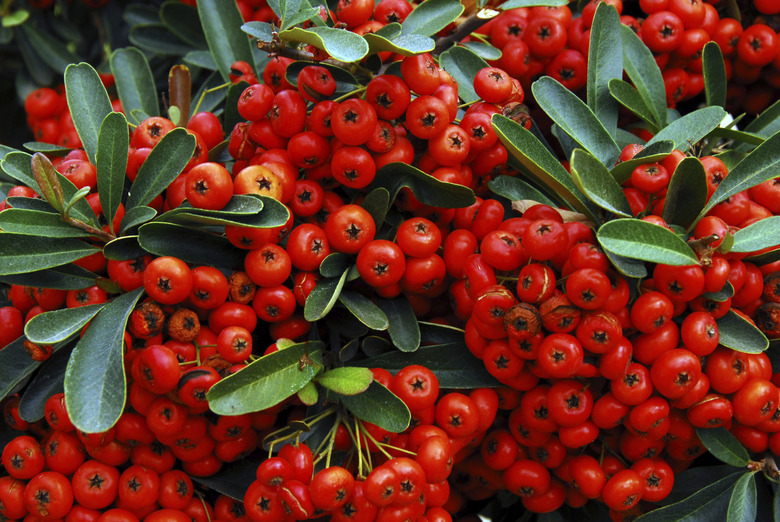How To Treat Black Leaves On Holly Bushes
Holly (Ilex spp.), sturdy shrubs or trees with thick, glossy leaves and colorful berries, generally grow in U.S. Department of Agriculture plant hardiness zones 3 through 11, depending on the species. Although hollies vary in size, fruit color and invasive characteristics, they share a susceptibility to a sooty mold disease that turns the leaves black. On holly plants, sooty mold typically occurs along with scale insect infestations. You can control both the sooty mold and the pests with cultural and chemical treatments.
About Sooty Mold
Sooty mold, a disease caused by the Capnodium fungus, looks like a black, powdery layer of soot on holly leaves and berries. The fungus grows on honeydew, a sweet, sticky substance excreted by soft scale insects after feeding on plant sap. Although the blackened foliage might look unattractive, the fungus doesn't directly attack the holly itself. It can affect a holly shrub indirectly by covering the leaves so they can't get enough sunlight for photosynthesis. This could result in reduced plant vigor, discolored foliage and stunted plant growth. In addition, the mold-covered leaves sometimes die and fall prematurely.
Checking for Scale Insects
Inspect your holly bush to confirm that a soft scale infestation is causing the black sooty mold. Scale insects generally look more like tiny growths on the foliage rather than actual bugs. Look on the stems and beneath the leaves for rounded, black or brown bumps no larger than 1/4 inch long. The bumps might look waxy, fuzzy or smooth. Symptoms of a scale infestation include yellowed, wilted or curled leaves.
Treating Scales Naturally
Controlling soft scale infestations will get rid of the honeydew and the resulting black sooty mold. Scraping the scales off using an old toothbrush or your fingernails can help control small numbers of scale insects. Pruning off infested branches can help control larger pest populations. Place the parts you pruned into a covered garbage can far away from your plants to prevent spreading the pests to other hollies in your yard. Wipe pruning tools with a cloth soaked in isopropyl alcohol before and after pruning each plant to sterilize them and avoid spreading the pests or any diseases.
Treating Scales Chemically
Treat severe scale infestations with neem oil, a lightweight horticultural oil that smothers plant pests. Carefully read and follow label instructions. One neem oil product recommends using 1 to 2 fluid ounces of product for every 1 gallon of water. Using a handheld garden sprayer, thoroughly wet down the entire bush with the solution, paying special attention to the undersides of leaves. Repeat applications every seven to 14 days until scale populations are under control.
Spray plants in the early morning or late evening to avoid killing pollinating insects and to reduce the risk of leaf burn. Spray oil only on calm days when the temperature is between 40 and 85 degrees Fahrenheit and rain isn't expected for at least 24 hours.
Controlling Sooty Mold
Sooty mold typically dries up and flakes off a holly's leaves once you control the scale insects. Squirting your shrub with a blast of water from a garden hose can help the process along. If the appearance of the black leaves really bothers you, mix 1 tablespoon of mild dish liquid with 1 gallon of water. Use a handheld sprayer to apply the solution to affected leaves. Allow the solution to sit for about 15 minutes before rinsing it from the bush with a strong jet of water from a garden hose. Repeat this process about once a week until the sooty mold disappears.
A Few Considerations
Various species of beetles, mites, parasitic wasps and lacewings naturally keep scale populations under control. Avoid using a broad-spectrum insecticides, which kill the beneficial insects as well as the pests, and plant flowers near susceptible bushes to attract the scale's natural enemies to your hollies. Give the predators easier access to the scales by rinsing dust off the foliage with your garden hose.
Although nontoxic to humans, horticultural oil can still cause eye and skin irritation. Reduce the risk of exposure by wearing a face mask, goggles, waterproof gloves, long sleeves, long pants and shoes with socks. Keep people and pets out of the treatment area until the solution thoroughly dries.
References
- University of California Statewide Integrated Pest Management Program: Holly — Ilex Spp.
- University of California Statewide Integrated Pest Management Program: Scale
- University of California Statewide Integrated Pest Management Program: Sooty Mold
- University of Missouri Extension: Aphids, Scales and Mites on Home Garden and Landscape Plants
- University of Florida IFAS Extension: Black, Sooty Mold on Landscape Plants
- Mississippi State University Extension Service: The Plant Doctor: Sooty Mold
- AgriLife Extension; Texas A&M System: Using Oils as Pesticides
